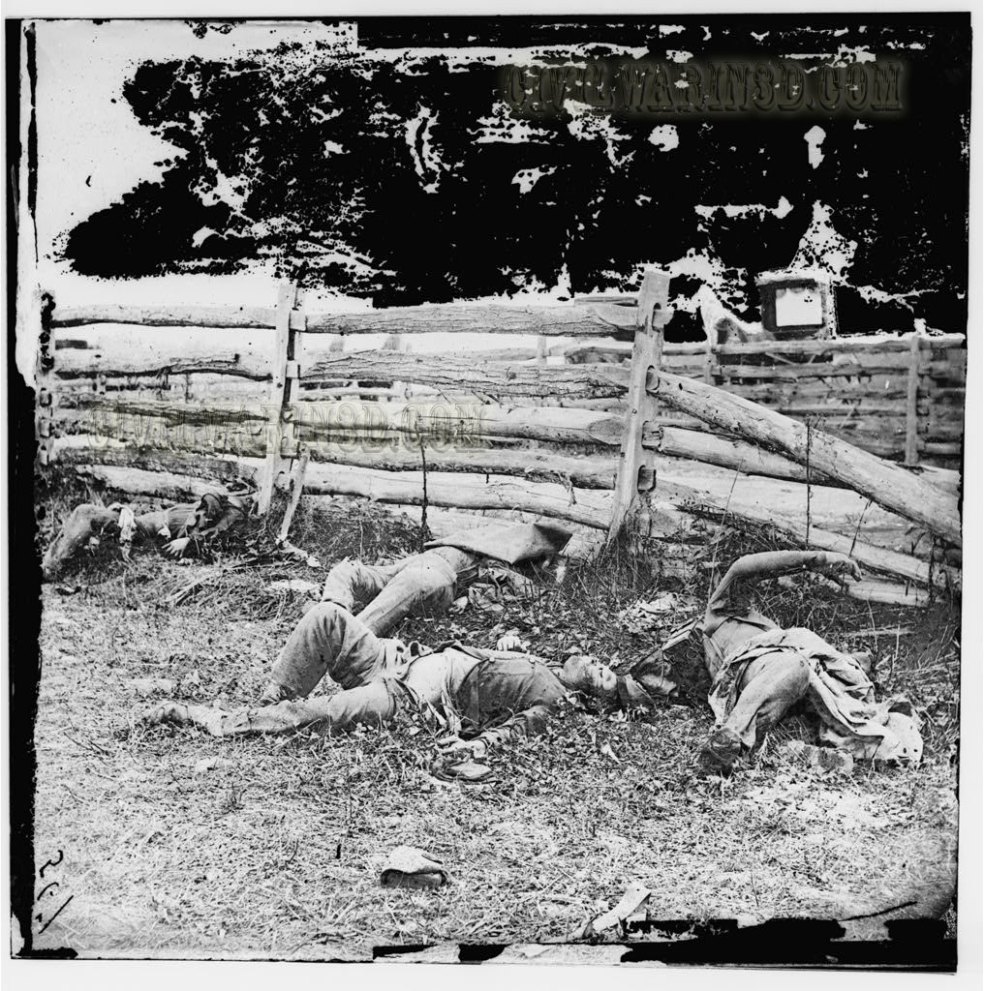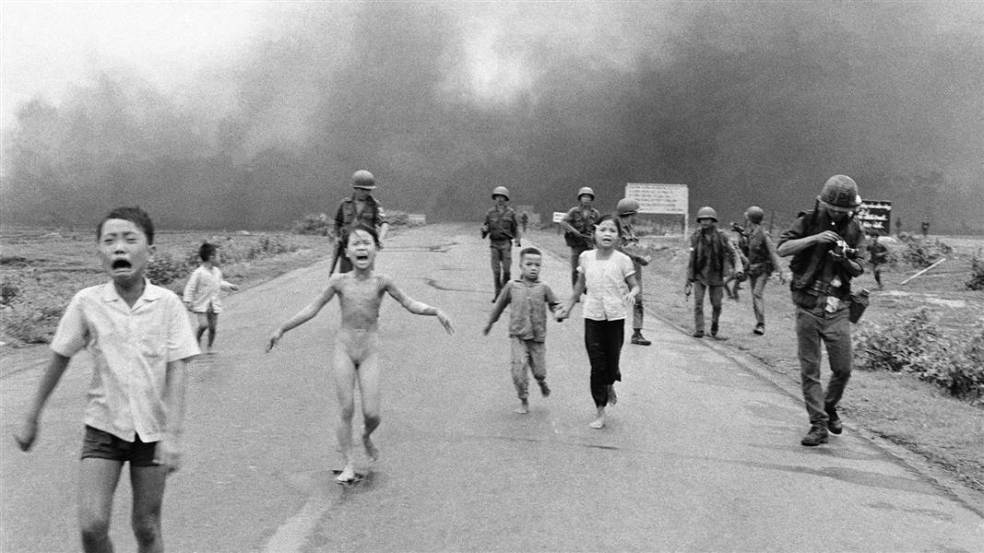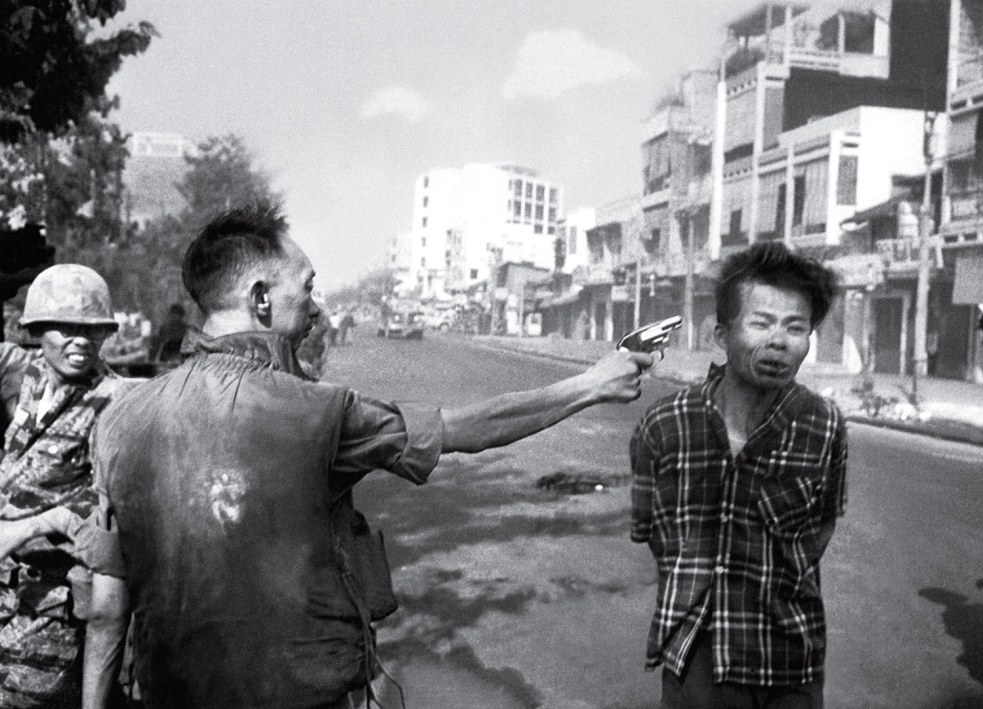War photography has been described as “photographing armed conflict and its effects on people and places” (‘War Photography’, 2017) and was said to be first introduced around the early 1850’s (Cosgrove, 2014). The first official war image attempt was produced by Gilbert Elliot when he was commissioned to photograph the views of the Russian fortifications, however, Roger Fenton has been described as the first definite war photographer (‘War Photography, 2017).
Mathew Brady was a self-taught Civil war photographer and is still often referred to as the “father of photojournalism” (Civil War Trust, 2017). His photos had a colossal impact on society at the time and would often evoke feelings of disturbance amongst the nation due to the brutal reality displayed.

Four deaths after combat (Brady, 1862)
The first picture to unnerve the public can be seen above. Brady managed to get a photo before the dead bodies of soldiers were moved off of the field after a battle. This photo was overwhelming to the viewers because they had been sheltered from the horrifying truth and tales that lay on the battlefield.
Although Brady’s photography opened eyes by unveiling the alarming matter of death by war, Nick Ut managed to create an immense rift between the involvement America had with war, eventually helping end the Vietnam war by taking one of the most “defining images of brutal conflict” (100photos, 2017).

A naked girl runs for safety after a bomb drops on her village (Ut, 1972)
Despair, pain and terror. By first glance, that is what is noticed. It is hard to forget the sobbing faces of these young Vietnamese children running and screaming towards safety. However, there is also the obvious presence of six completely nonchalant soldiers. Looking down, talking to one another, strolling along the wide-set pavement, suggesting that this is the normal reality; a constant feeling of melancholy.
This photograph (Ut, 1972) was first looked at hesitantly by newspapers due to the ability it had to cause others to feel “offended”. But why shouldn’t one feel offended? It highlighted the terrible ongoing issue of war and how it affected children’s lives. However, because nine year old, Kim Phuc, was naked, it somehow “distracts” that dilemma. Society is more likely to focus on the young child being naked in order to distract themselves from the daunting reality of war. By presenting this raw and honest photograph of the terror war causes amongst communities, it creates fear which the audience may not respond to. Society distance themselves from the harsh reality of war as they cannot fathom what “The terror of war” is presenting. The most ironic thing being, that she was naked due to the military. The Guardian (2015) stated that they accidentally dropped napalm on civilians in Phuc’s village, Trang Bang, outside of Saigon which caused her clothes to catch fire, eventually giving severe life-long burns. Because of this, she took the conscious decision to rip off her burning clothes to prevent further damage to herself, ultimately running towards buckets of water which were later poured on her by the soldiers (Time, 2016). All together, Phuc suffered burns on over a third of her body and managed to survive, despite being told she would not (The Guardian, 2015). Ut recalled being congratulated because “the picture was immediately on the front page of every newspaper and on TVs” as well as there being “anti-war protests all over the world” the very next day (Zhang, 2012).

Nick Ut and Kim Phuc embrace after reuniting (Hong, 2012)
Now nearly forty years later, Phuc has become a motivational speaker, sharing her survivor story as well as launched a foundation in the US with the aim to provide medical and psychological care to child victims of conflict (‘Phan Thi Kim Phuc’, 2017). She has allowed herself to create an afterlife despite bearing very rough beginnings and continues to be a living symbol of the Vietnam war (Ut, 1972). She has managed to keep in touch with Ut and even refers to him as her family; Uncle Ut (The Guardian, 2015). This decidedly shows that positive impacts do exist within war photography.

Americas culture vs. Americas burden (Banksy, 2005)
The original photo has been diversely appropriated by many artists. For example, Banksy. Banksy recreated the photo (Banksy, 2004), however, inserted Ronald McDonald and Mickey Mouse side by side of Kim Phuc, latching onto her arms. What does this mean? Well it could mean a number of things. Ronald McDonald and Mickey Mouse could represent mass American pop culture and it could exemplify how American Capitalism has a hold over foreign children (V&A, 2017). They are not recognised or even put in the same category as American children and are even used in inhumane labour. The egotistical looks on their faces counterbalance the troubled face of Kim Phuc and in fact, mock the matter of her crying for help. It shows the connection between soft and sweet American culture with the reality of what America really is as a colonel power (Zaynabkjp, 2012). Banksy invites viewers to really admit that “the war is a multi-billion dollar industry with very powerful corporate lobbies” (Stencil Revolution, 2017).

Impulsive execution of prisoner by General (Adams, 1968)
Another example and iconic war photograph would be the Saigon Execution (Adams, 1968), however, the outcome this photograph created was horribly unexpected and turned for the worst. Reading into this photo, it holds a lot of misery. Injustice. Brutality. Suffering. But what we don’t know is that it is being misunderstood. Who we presume is the victim, was actually Nguyễn Văn Lém, who was referred to as “Captain Bay Lop” (‘Nguyễn Ngọc Loan’ (2017). Bay Lop was a member of the National Liberation Front and was responsible for “killing the wife and 6 children of a South Vietnamese military officer”. He was caught in the act at the scene where there were over seven police family members dead bodies (‘Execution of Nguyễn Văn Lém’, 2017). General Nguyễn Ngoc Loan, who is being understood as the villain, took it upon himself to shoot Bay Lop with the idea that it could bring justice. In the split second that it took to shoot him in the side of his head, Adams managed to snap a photo. The video (Dszymanski2, 2014) actually captures that moment with Bay Lop falling to the concrete road, as well as how briskly the situation was handled.
In the YouTube video (Fpzzuuulzgaxd, 2008), Adams agreed with the General’s actions of shooting the prisoner stating “I might have done the same thing” because “I had seen so many die at the point in my life”. He also discussed how misconceived the photo had become; “I had no idea of the impact and I still don’t understand it today”. After the photo was released, Adams reflected back often commenting “that picture destroyed his (General Nguyễn Ngoc Loan) life and that’s what bothers me more than anything” (Fpzzuuulzgaxd, 2008) and “the general killed the Viet Cong; I killed the general with my camera” (Time, 2001).
The image proved to have the strength to build extreme amounts of hate for a foreigner in an out of context photograph and was then recognised as an “anti-war” symbol. This encouraged people to take matters into their own hands moreover the disgust for General Nguyễn was revealed in several ways. Nguyễn had been refused treatment from an Australian hospital due to the photo after an attack that resulted into the amputation of his right leg. He was also forced into closing his family Pizza business he had in DC, Virginia because of the low amount of customers and threats he received on a daily basis by the local community (Pdoggbiker, 2015). Nguyễn reminisces one morning when he came into work, he found “we know who you are fucker” written on the toilet wall (Rare Historical Photos, 2017).
It’s clear misinformed perceptions can result in unjust consequences (in Nguyễn’s case it was verbal and physical annihilation) due to the lack of crucial information the subjects actually have on the matter. Adams met and apologised to General Nguyễn and his family for ruining his reputation. After Nguyễn died of cancer, Adams celebrated him: “The guy was a hero. America should be crying. I just hate to see him go this way, without people knowing anything about him” (Time, 2001).

Brave man incautiously stops war tanks (Widener, 1989)
“A Chinese man stands alone to block a line of tanks heading east on Beijing’s Changan Avenue in Tiananmen Square on June 5, 1989. The man, calling for an end to the recent violence and bloodshed against pro-democracy demonstrators, was pulled away by bystanders, and the tanks continued on their way. Jeff Widener—AP” (Pickert, 2014).
Previously on June 3rd, Jeff Widener had been attacked by a Chinese thug who used a rock to strike him in the head, almost causing a concussion and fatality as well as smashing one of his cameras. Although Widener was injured, he was still asked to photograph the events which would later occur the following days on Tiananmen Square. To compromise between his health and his work, he decided to stay at the Beijing Hotel and would sleep off his headache in between taking photos from his balcony on the 6th floor (‘Tank Man’, 2017).
From what happened within the next few moments could only be described as dreadfully courageous. After a line of tanks began to form along the street, a man crossing the lane stopped in front of the tanks and stood there faced towards them. It was evident that he wanted to block the tanks and keep them stopped. Widener stated that he “waited and waited” for the moment the man would get shot but “he wasn’t.” Instead, “the man waved his arms in front of the lead tank as it tried to proceed around him and eventually, he climbed on top of the hulking metal” (Pickert, 2014).
It is said that “Tank Man” was actually a nineteen year old student (Saul, 2014) however, his name could not be traced. Although the actions of this student were deemed brave and one of the most iconic moments of the 20th century, no one seemed to think about the backbone the tank driver had. He could have shot and killed this man after he continuously violated them by disturbing their march. Instead a YouTube video(CNN, 2014) reveals that he talked to the man, heard him out and even tried to move around him.
This photograph (Widener, 1989) has been remade countless times ranging from comedic to very serious. The Simpsons actually created an episode which had an obvious influence of this event. From Homer standing in front of 4 lined taxi’s and mimicking the Tank Man’s movements (Amirali Mohajerpour Iravani, 2012) to a sign stating “Tiananmen Square: On this site, in 1989, NOTHING HAPPENED” (Worteltaart, 2009). Shows like Family Guy have also included this political issue (DontMindMyController, 2015).
Even discussing this topic in China is still considered taboo and unacceptable. In 2013, a remake of the picture was posted onto the website ‘Sina Weibo’. Rather there be tanks, there for 4 big yellow ducks. Using Dutch artist, Florentijn Hofman’s 54ft tall duck that was floating around Hong Kong at the time (Kelley, 2013), it was photoshopped in. The photo was a metaphor for the fact that the subject was prohibited, hiding the tanks with something else to cover it up. This eventually caused Chinese censors to ban the word “Big yellow duck” also from their search, adding that to “Tiananmen”, “1989”, “Square”, ‘Tank”, “Student leaders” and “June 4” (BBC, 2014).

Comical photo that was posted anonymously online (Sina Weibo, 2013)
These examples all demonstrate the effects war photography has had on humanity which vary from favourable (Kim Phuc being able to help children who go through the same bearings as herself) to depressing (the Saigon Execution negatively affecting General Nguyễn’s life up until he died). With governments intervening by censoring search engines to attacks on innocent people but also, giving hope to the public to be able to stand up for they believe in. It goes to show how just these simple photographs were able to expand into different areas of professionalisms, affect the minds of citizens and exhibit the technological revolution war photography generated on civilisation, society and media.
Bibliography:
100photos (2017) The Terror of War. Available at: http://100photos.time.com/photos/nick-ut-terror-war (Accessed: 1 December 2017).
Adams, E. (1968) Saigon Execution. Available at: http://100photos.time.com/photos/eddie-adams-saigon-execution (Downloaded: 27 November 2017).
Amirali Mohajerpour Iravani (2012) Simpsons Tiananmen Parody. Available at: https://www.youtube.com/watch?v=e8_tiks1l1o (Accessed: 20 October 2017).
Banksy. (2005) Napalm. Available at: http://collections.vam.ac.uk/item/O116030/napalm-print-banksy/ (Downloaded: 15 November 2017).
BBC (2014) #BBCtrending: 10 Words Blocked on Weibo for Tiananmen Anniversary. Available at: http://www.bbc.co.uk/news/blogs-trending-27700982 (Accessed: 22 November 2017).
Brady, M. (1862) Antietam, Maryland. Bodies of Dead, Louisiana Regiment. Available at: http://www.civilwarin3d.com/loc/MD/Antietam/Dead/slides/01104.html (Accessed: 29 November 2017).
Civil War Trust (2017) Biography Mathew Brady. Available at: https://www.civilwar.org/learn/biographies/mathew-brady (Accessed: 29 November 2017).
CNN (2013) 1989: Man vs. Chinese tank Tiananmen square. Available at: https://www.youtube.com/watch?v=YeFzeNAHEhU (Accessed: 2 December 2017).
Cosgrove, B. (2014) Time. Available at: http://time.com/3881577/crimea-where-war-photography-was-born/ (Accessed: 1 December 2017).
DontMindMyController (2015) Family Guy S1XE1 Man Stops Tank. Available at: https://www.youtube.com/watch?v=raO0x75y5hM (Accessed: 23 November 2017).
Dszymanski2 (2014) Nguyễn Van Lem execution and Kim Phuc video. Available at: https://www.youtube.com/watch?v=bst9mjjiBBo (Accessed: 29 November 2017).
‘Execution of Nguyễn Văn Lém’ (2017) Wikipedia. Available at: https://en.wikipedia.org/wiki/Execution_of_Nguy%E1%BB%85n_V%C4%83n_L%C3%A9m (Accessed: 28 November 2017).
Fpzzuuulzgaxd (2008) Eddie Adams Talk About The Saigon Execution Photo. Available at: https://www.youtube.com/watch?v=Bv11KilBpHQ (Accessed: 29 November 2017).
Hong, J.C. (2012) Kim Phuc Hugs Nick Ut. Available at: https://www.theguardian.com/us-news/2015/oct/26/vietnam-wars-napalm-girl-kim-phuc-has-laser-treatment-to-heal-wounds (Downloaded: 13 November 2017).
Kelley, M.B. (2013) China Blocks Searches For ‘Big Yellow Duck’ After Brilliant Tiananmen Square Pun. Available at: http://www.businessinsider.com/chinese-censors-block-big-yellow-duck-2013-6?IR=T (Accessed: 22 November 2017).
‘Mathew Brady’ (2017) Wikipedia. Available at: https://en.wikipedia.org/wiki/Mathew_Brady (Accessed: 28 November 2017).
‘Nguyễn Ngọc Loan’ (2017) Wikipedia. Available at: https://en.wikipedia.org/wiki/Nguy%E1%BB%85n_Ng%E1%BB%8Dc_Loan (Accessed: 28 November 2017).
Pdoggbiker (2015) ‘The Story Behind the Famous “Saigon Execution” Photo’, Cherries – A Vietnam War Novel, 3 August. Available at: https://cherrieswriter.wordpress.com/2015/08/03/the-story-behind-the-famous-saigon-execution-photo/ (Accessed: 3 December 2017).
‘Phan Thi Kim Phuc’ (2017) Wikipedia. Available at: https://en.wikipedia.org/wiki/Phan_Thi_Kim_Phuc#Adult_life (Accessed: 14 November 2017).
Pickert, K. (2014) Tank Man at 25: Behind the Iconic Tiananmen Square Photo. Available at: http://time.com/3809688/tank-man-iconic-tiananmen-photo/ (Accessed: 22 November 2017).
Rare Historical Photos (2017) Saigon Execution: Murder of a Vietcong by Saigon Police Chief, 1968. Available at: https://rarehistoricalphotos.com/saigon-execution-1968/ (Accessed: 3 December 2017).
Saul, H. (2014) Independent. Available at: http://www.independent.co.uk/news/world/asia/tiananmen-square-what-happened-to-tank-man-9483398.html (Accessed: 1 December 2017).
Sina Weibo. (2013) Untitled. Available at: http://www.dailymail.co.uk/news/article-2335636/China-bans-internet-searches-big-yellow-duck-Tiananmen-Square-anniversary-clampdown-prankster-substitutes-ducks-tanks-viral-image.html (Downloaded: 26 November 2017).
Stencil Revolution (2017) Ronald McDonald and Mickey Mouse. Available at: https://www.stencilrevolution.com/banksy-art-prints/ronald-mcdonald-and-mickey-mouse/ (Accessed: 20 November 2017).
Tank Man (2017) Wikipedia. Available at: https://en.wikipedia.org/wiki/Tank_Man (Accessed: 20 October 2017).
The Guardian (2015) Vietnam war’s ‘napalm girl’ Kim Phuc has laser treatment to heal wounds. Available at: https://www.theguardian.com/us-news/2015/oct/26/vietnam-wars-napalm-girl-kim-phuc-has-laser-treatment-to-heal-wounds (Accessed: 13 November 2017).
Time (2001) ‘Eulogy’. Available at: http://content.time.com/time/magazine/article/0,9171,139659,00.html (Accessed: 1 December 2017).
Time (2016) The Terror of War: Nick Ut’s Napalm Girl. Available at: http://time.com/4485344/napalm-girl-war-photo-facebook/ (Accessed: 22 November 2017).
Ut, N. (1972) The Terror of War. Available at: http://all-that-is-interesting.com/napalm-girl (Downloaded: 25 November 2017)
V&A (2017) Napalm. Available at: http://collections.vam.ac.uk/item/O116030/napalm-print-banksy/ (Accessed: 21 November 2017).
‘War photography’ (2017) Wikipedia. Available at: https://en.wikipedia.org/wiki/War_photography (Accessed: 26 November 2017).
Widener, J. (1989) Tank Man. Available at: http://100photos.time.com/photos/jeff-widener-tank-man (Downloaded: 27 November 2017).
Worteltaart (2009) References Towards Tiananmen Square Protests of 1989. Available at: https://vimeo.com/4995732 (Accessed: 23 November 2017).
Zaynabkjp. (2012) Napalm (2004-5) Banksy. Available at: https://jamaispasdutoutrien.wordpress.com/2012/10/15/napalm-2004-5-banksy/ (Accessed: 20 November 2017).
Zhang, M. (2012) Interview with Nick Ut, the Photojournalist Who Shot the Iconic “Napalm Girl” Photo. Available at: https://petapixel.com/2012/09/19/interview-with-nick-ut-the-photojournalist-who-shot-the-iconic-photo-napalm-girl/ (Accessed: 3 December 2017).